Types of Acorn Trees (With Pictures) – Identification Guide
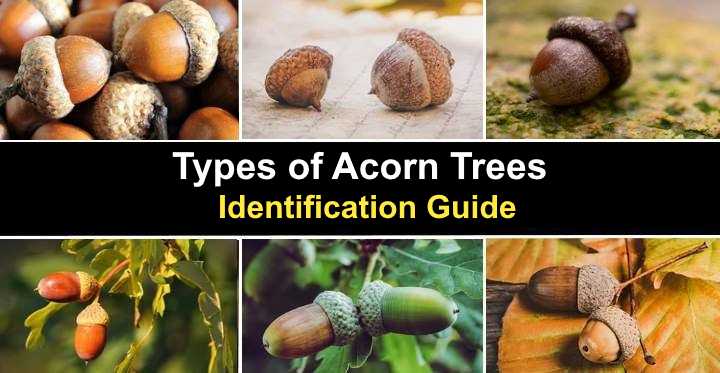
Acorn trees are species of hardwood trees in the genus Quercus — commonly known as oak trees. These acorn-producing trees are easily identified in the landscape due to their characteristic lobed oak leaves, large, spreading canopy, and brown nuts nestling in a small wart cap — the easily recognizable acorns.
Trees that produce acorns are valuable shade trees that also produce edible nuts. When prepared correctly, the acorns from many oak trees have a sweet, buttery taste. Additionally, oak tree acorns are a valuable food source for wildlife, giving them nourishment during winter months.
This article is a guide to identifying several types of acorn-producing trees. In many cases, oak tree identification is possible by looking at the acorns the tree produces. Therefore, descriptions and pictures of acorns from trees will help you know the oak tree species.
What Are Acorns?
An acorn is the nut or fruit of an oak tree. The acorn is typically an oval, barrel, or egg-shaped brown nut sitting in a warty or scaly cap called a cupule. Depending on the species of tree, the acorn or oak nut can take six to 24 months to mature, and acorn-producing trees give a bountiful harvest every four years.
Acorns from oak trees contain high levels of tannins, giving raw acorns a bitter taste. Therefore, if you plan on eating harvested acorns, you must prepare them by leeching the tannic acid from the nuts. Depending on the tree species, acorns can taste relatively sweet and nutty.
Types of Acorn Trees (With Pictures) — Identification Guide
Let’s look in more detail to learn more about 19 species of oak trees and their acorns.
White Oak Tree (Quercus alba)
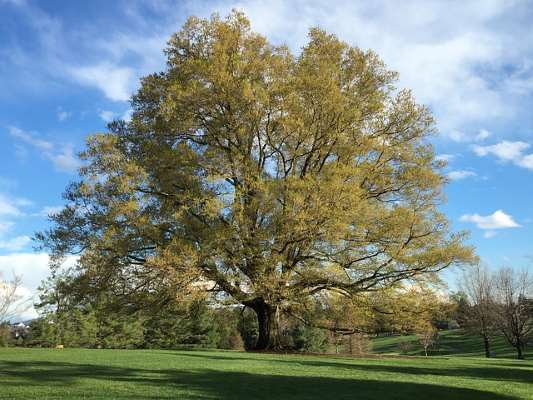
White oak tree (Quercus alba)
The acorn-producing white oak tree is a large deciduous tree producing brown nuts. White oak tree acorns are oblong or egg-shaped with a rounded end and pointed tip. The light tan-colored nut sit is a short warty cap. The tree acorns ripen from September through November.
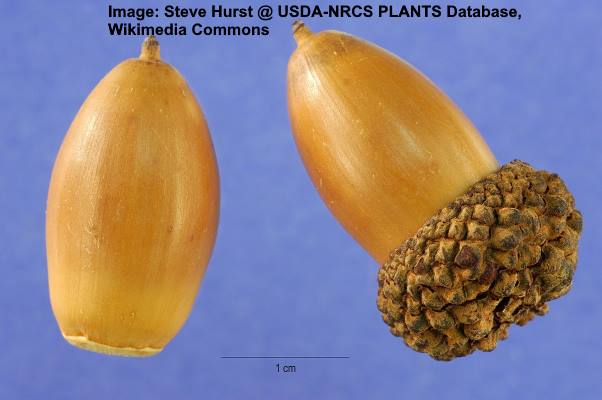
White oak acorns
White oak trees have a dense, pyramidal, spreading habit and slow growth rate. The majestic trees grow 50 to 135 ft. (15 – 41 m) tall and up to 80 ft. (24 m) wide. The tan-colored acorns measure 1” (25 mm) long, and the lobed leaves are 4” to 9” long (100 – 220 mm).
English Oak Tree (Quercus robur)

English oak tree (Quercus robur)
The English oak is an acorn-producing hardwood tree. The acorn tree is identified by its rounded canopy, oblong leaves with deeply lobed margins, and egg-shaped, oblong acorns. Additionally, this stately shade tree has blackish-gray bark. The English oak grows 40 to 70 ft. (12 – 21 m) tall and wide.
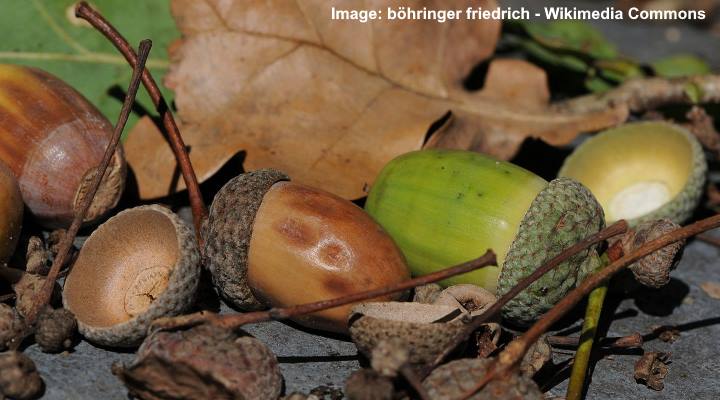
English oak acorns
Acorns are ready for harvesting on an English oak tree during fall. The brown oval nuts measure 1” (25 mm) long with a bumpy cap covering one-third of the acorn.
Shumard Oak Tree (Quercus shumardii)
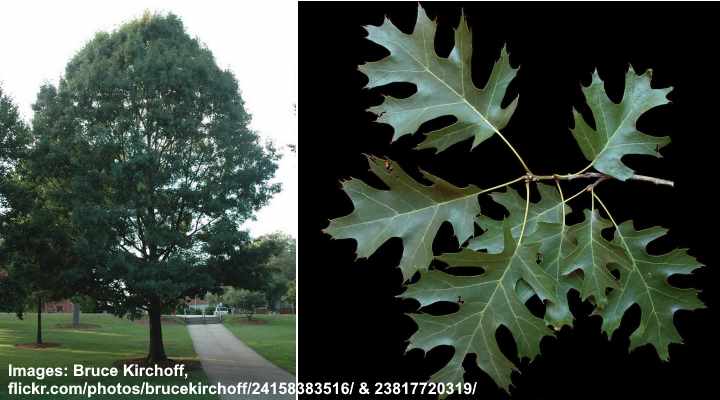
Shumard oak (Quercus shumardii) tree and leaves
The acorn-producing Shumard oak is a type of red oak species. This oak has an attractive pyramidal shape, leaves with pointed lobes, and coppery-brown oblong acorns. The acorn tree grows 50 to 70 ft. (15 – 21 m) tall and 30 to 40 ft. (9 – 12 m) wide.
The identifying feature of this acorn tree is its spiky-looking lobed leaves with bristle tips. These leaves measure 4” to 8” (100 – 200 mm) long.
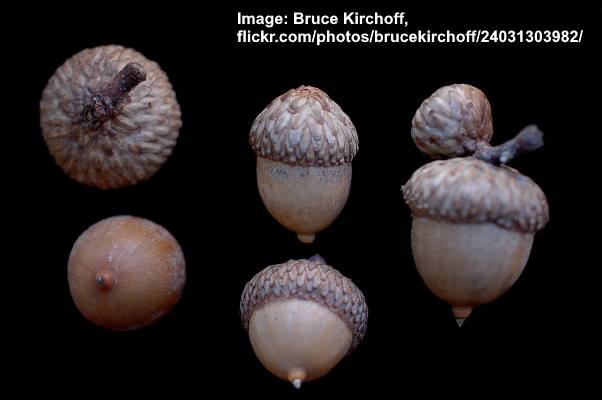
Shumard oak acorns
Acorns on the Shumard oak tree are short and stocky, almost barrel-like. The tree nuts measure 1.25” (30 mm) long and 1” (25 mm) wide, and sit in a thin, shallow cap. Apart from the bur tree acorns, these are some of the largest acorns you will find
Pin Oak Tree (Quercus palustris)
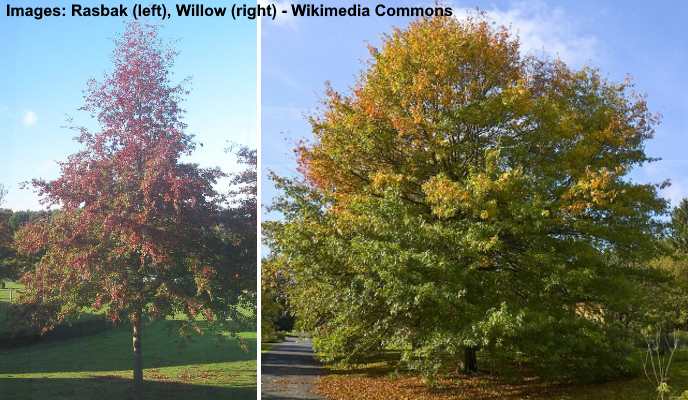
Young and mature pin oak trees (Quercus palustris)
The pin oak tree produces small, dark, flat topped acorns — some of the sweetest of all acorn tree species. Identifying features of the pin oak tree are its dark green leaves with pointed lobes, round, dark-colored acorn fruits, and smooth gray bark. The oak tree thrives in swampy ground.
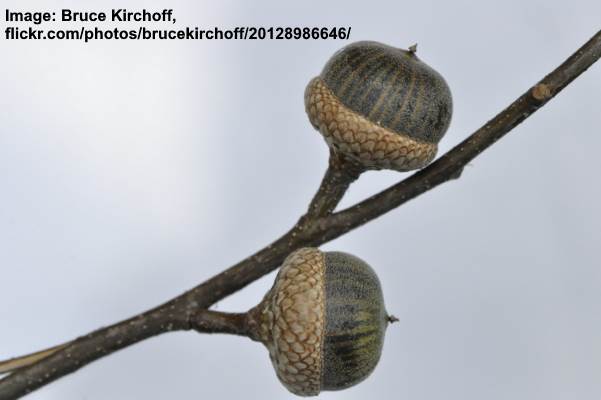
Pin oak tree acorns
This acorn tree has tremendous landscaping appeal due to its fall foliage of orange, bronze, or red colors. A unique feature of this deciduous tree is that its leaves remain on the branches throughout the winter. The pin oak grows 60 to 70 ft. (18 – 21 m) tall and 46 ft. (14 m) wide.
Bur Oak Tree (Quercus macrocarpa)
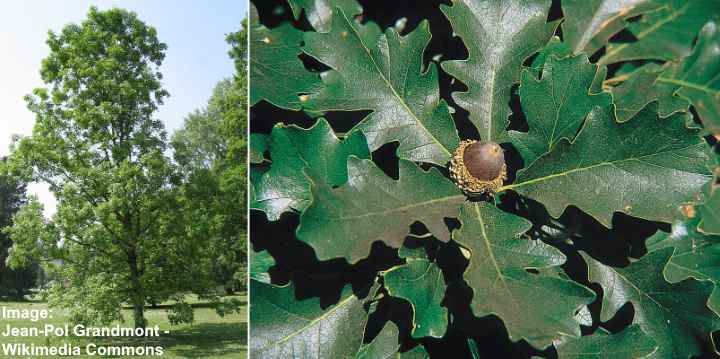
Bur oak (Quercus macrocarpa) tree, leaves and acorn
The bur oak tree produces some of the largest acorns of all the Quercus species. In addition, the tree’s acorns are some of the sweetest when prepared. This species of oak has unusual leaves in a violin shape, large oval acorns, and clusters of golden yellow flowers.
The acorn-producing bur oak grows 70 to 80 ft. (21 – 24 m) tall and wide. As the deciduous acorn tree matures, it develops a spreading, rounded open canopy, making it ideal as a shade tree.
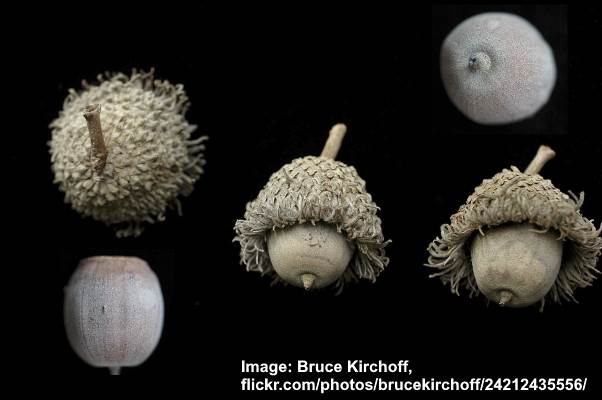
Bur oak acorns
The tree’s acorns are described as showy nuts with a pale grayish-brown or copper color. The large oak fruits grow 1.5” (38 mm) long and wide with a scaly cap covering over one-half of the nut.
Willow Oak Tree (Quercus phellos)
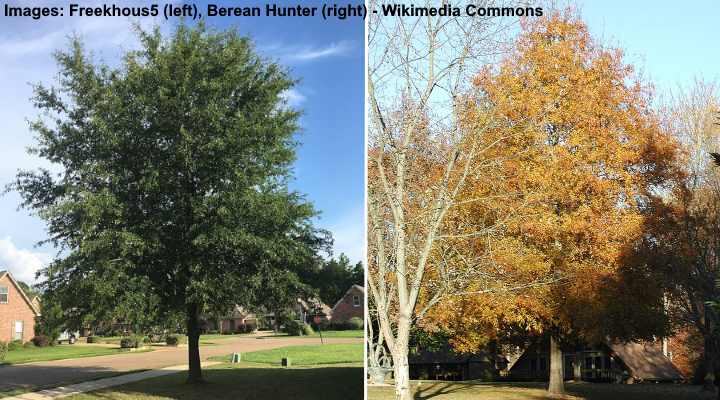
Willow oak trees (Quercus phellos). Right picture: Willow oak in autumn
The willow oak is a type of acorn-producing tree with glossy-green lance-shaped leaves resembling those of a willow tree. The dark willow oak acorns are relatively small, only measuring 0.5” (1.18 cm) long, and have a rounded shape. Willow oaks grow 40 to 75 ft. (12 – 23 m) tall and 25 to 50 ft. (7.6 – 15 m) wide.
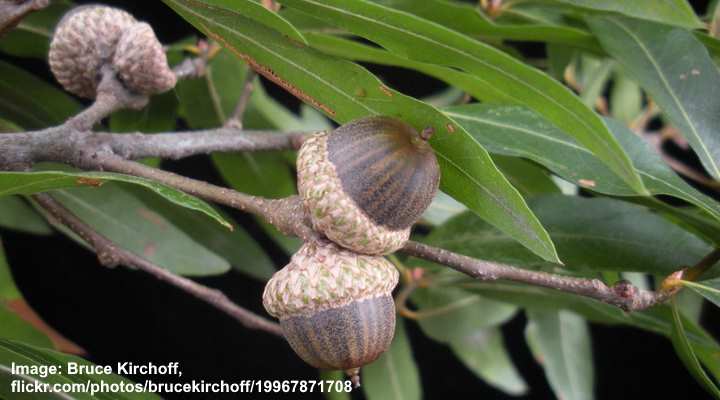
Willow oak tree acorns
The willow oak is a species of oak tree native to the southeastern United States. Identifiable features of the oak tree are its lanceolate, oblong leaves measuring 5” (130 mm) long, golden yellow, orange, or red fall colors, and dark brown, furrowed bark.
Northern Red Oak Tree (Quercus rubra)
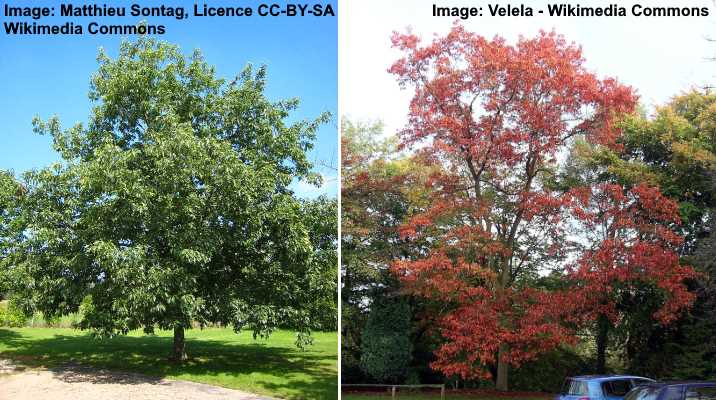
Northern red oak trees (Quercus rubra). Right picture: Northern red oak in autumn
The Northern red oak is a native acorn-producing tree in the oak family that has large oval leaves featuring pointed lobes. This species of red oak has a fast growth rate and develops a rounded crown. The large leaves measure 7” (18 cm) long and turn copper or red in the fall.
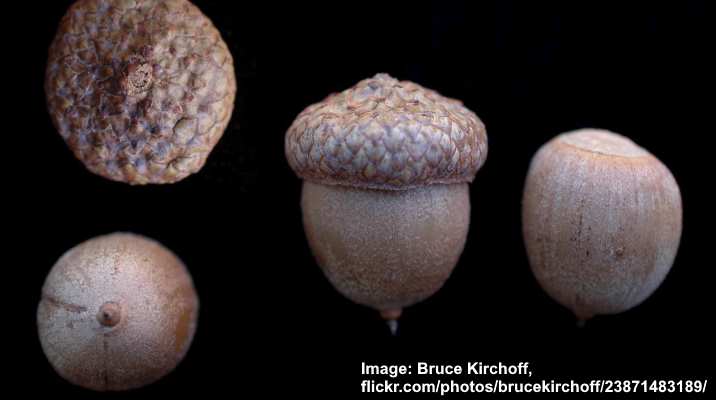
Northern red oak acorn
The northern red oak acorns are a reddish-brown in color with a smooth surface. The oak nut measures 0.75” to 1” (20 – 25 mm) long and sits in a bulging, wide cap. The mature trees take around 50 years to produce significant amounts of acorns.
Southern Live Oak Tree (Quercus virginiana)
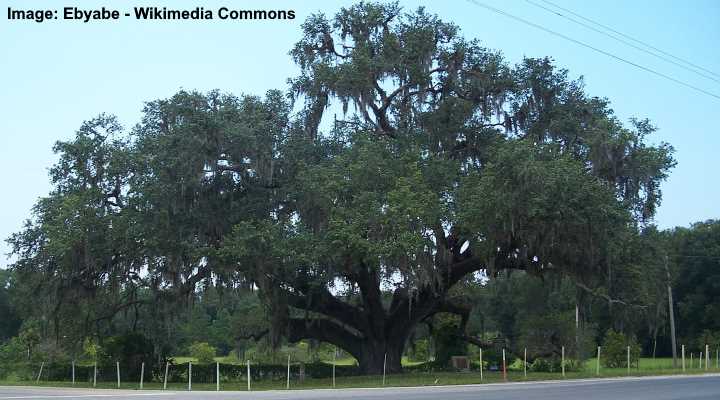
Southern live oak tree (Quercus virginiana)
The southern live oak is a broadleaf, evergreen acorn-producing tree that thrives in warm climates. The identifying features of the oak tree are its black acorns, glossy, leathery leaves, and small clusters of greenish-yellow flowers. The medium-sized acorn tree grows 40 to 80 ft. (12 – 24 m) tall and up to 100 ft. (30 m) wide.
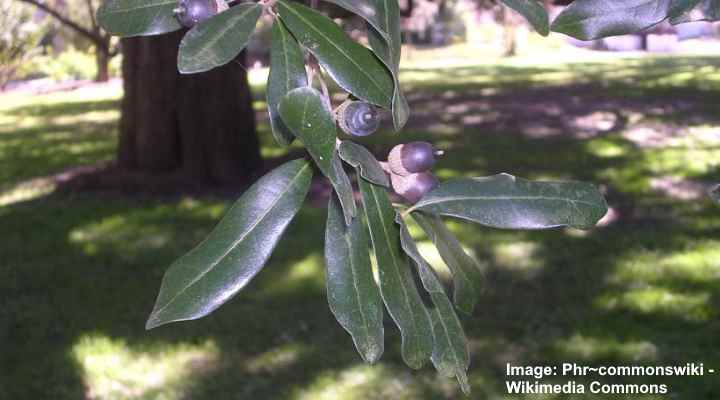
Southern live oak leaves and acorns
Acorns on the southern live oak tree are egg-shaped, blackish-brown, and measure 0.75” to 1” (20 – 25 mm) long. These black acorns sit in a bowl-shaped cap covered in pointed scales and cover one-third of the dark-colored acorn.
Scarlet Oak Tree (Quercus coccinea)
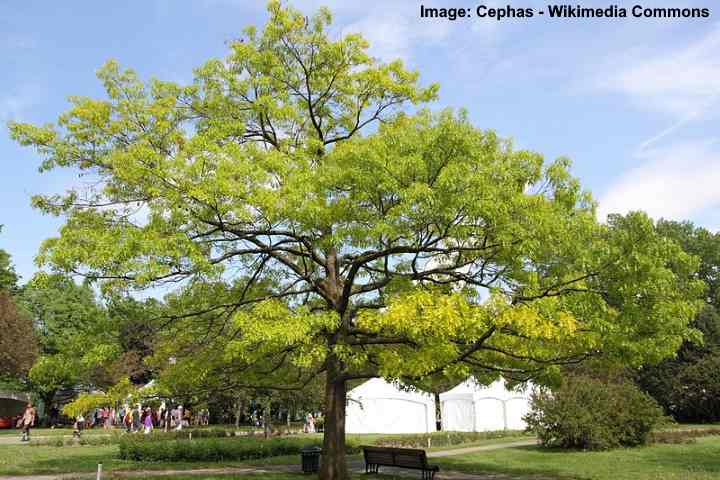
Scarlet oak tree (Quercus coccinea)
The scarlet oak is a deciduous acorn-producing tree with glossy green leaves and bright red autumn foliage. Identifying features of the scarlet oak are its leaves with pointed lobes, a dark gray bark with fissures revealing an orange inner bark, and small brown acorns.

Scarlet oak acorns
The acorns on a scarlet oak tree are brown-copper and grow 0.5” to 1” (12 – 25 mm) long. The brown nuts sit in a deep bowl-like cap. The stumpy acorns also have a pronounced nib on their tips. Like all oak fruits, the tree’s raw acorns taste bitter.
Scarlet oaks grow 50 to 80 ft. (15 – 4 m) tall and 45 to 60 ft. (13 – 18 m) wide. They thrive in USDA zones 4 to 9 in full sun and well-drained acidic soil.
Southern Red Oak Tree (Quercus falcata)
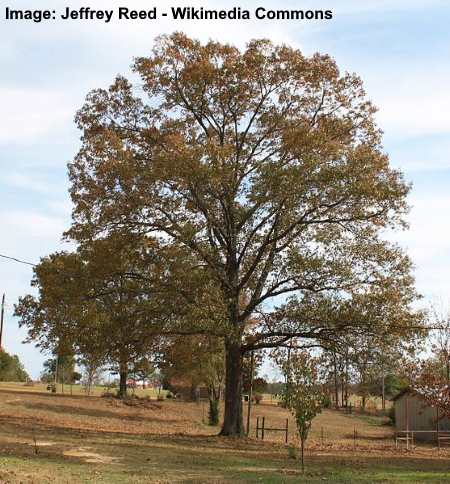
Southern red oak tree (Quercus falcata)
The acorn-producing southern red oak is native to North America and a popular shade tree in warmer climates. This majestic deciduous tree has pear-shaped leaves with three rounded lobes. The tree acorns are oval to round and relatively small. The southern red oak grows 60 to 100 ft. (18 – 30 m) tall and 50 to 60 ft. (15 – 18 m) wide.
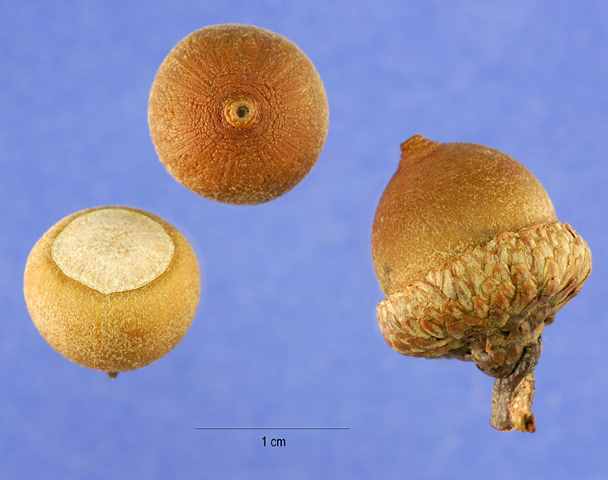
Southern red oak acorns
The southern red oak tree acorns are small pale brown nuts with a dome shape. These oak fruits measure 0.3” to 0.5” (7 – 13 mm) long. They also feature a flat, woody cap covering about one-third of the oval acorn.
Black Oak Tree (Quercus velutina)
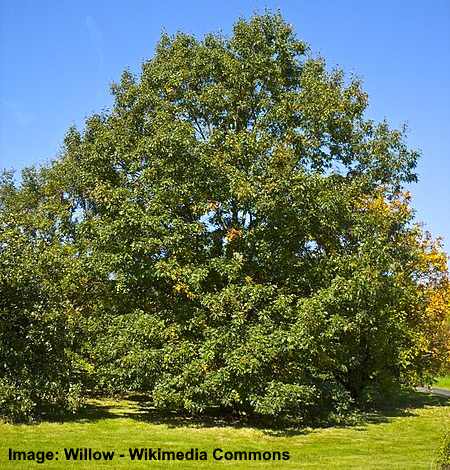
Black oak tree (Quercus velutina)
The black oak is a medium-sized oak tree that produces an abundance of acorns in the fall. Characteristics of the black oak are its silvery-green lobed leaves, light or golden brown acorns sitting in fringed caps, and thick, dark gray bark. The black oak has an irregular crown, and the mature oaks measure 50 to 60 ft. (15 – 18 m) tall and wide.

Black Oak Acorn (Quercus velutina)
Black oak acorns measure 0.5” to 1” (13 – 25 mm) long and have a slightly domed shape. The small acorns sit in a flat cup with loose scales. The cupule measures just under half the length of the acorn.
Chinquapin Oak Tree (Quercus muehlenbergii)
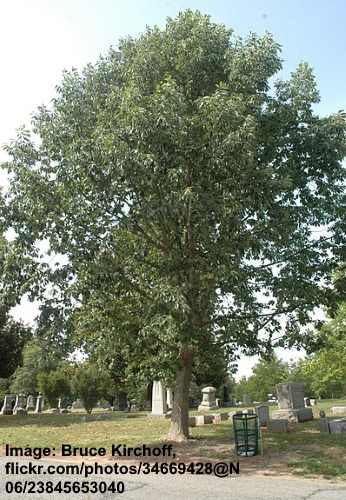
Chinquapin oak tree (Quercus muehlenbergii)
The Chinquapin oak produces relatively small acorns compared to other species of oak tree. This acorn tree is a medium-sized shade tree. It features oblong or lanceolate leaves with serrated margins, small clusters of yellowish flowers, and light gray bark. This species of white oak grows 40 to 60 ft. (12 – 18 m) tall and 50 to 70 ft. (15 – 21 m) wide.
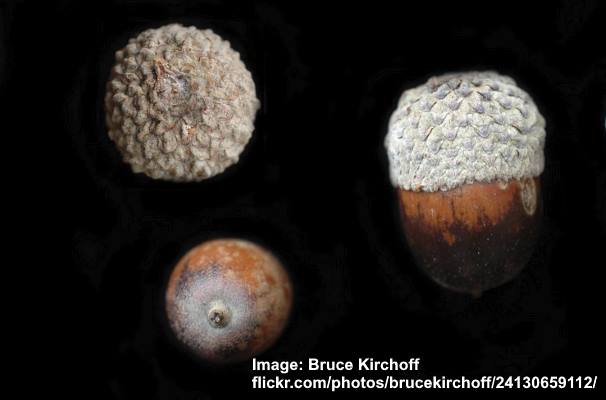
Chinkapin oak acorns
Chinquapin oak tree acorns are dark brown to black and only measure 0.75” (20 mm) long. The egg-shaped to ovoid nuts sit in a pale gray cap, giving the acorns a unique appearance. Once prepared, the raw acorns are some of the sweetest you can find in deciduous woodlands.
California Live Oak Tree (Quercus agrifolia)
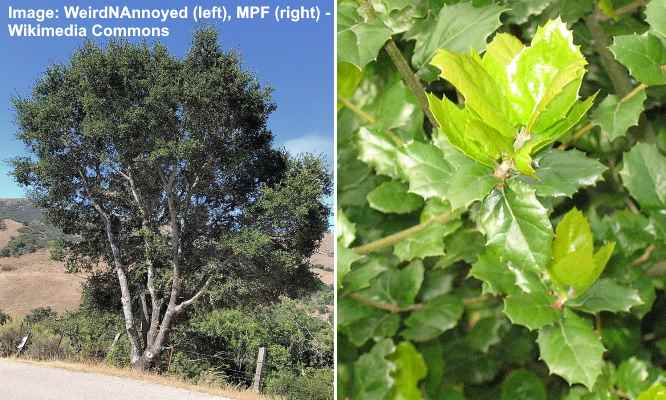
California live oak (Quercus agrifolia) tree and leaves
Also called the coast live oak, this native California acorn-producing tree has dense, evergreen foliage. Attractive characteristics of this evergreen oak are its holly-like dark green leaves, egg-shaped brown acorns, and gnarled, crooked, spreading branches. The California live oak grows 20 to 50 ft. (6 – 15 m) tall and wide.

California live oak acorns
Acorns produced by the coast live oak tree are narrowly conical-shaped and reddish-brown to dark brown. These acorns measure 0.75” to 1.5” (20 – 35 mm) long and sit in relatively smooth orangey-brown cups that cover about one-quarter of the fruit.
Post Oak Tree (Quercus stellata)
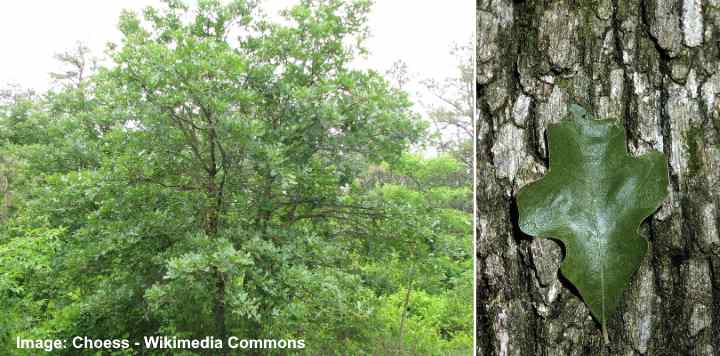
Post oak (Quercus stellata) tree, bark and leaves
The post oak is a small deciduous acorn tree growing 40 to 50 ft. (12 – 15 m) tall. Identifying features of the post oak tree are its glossy green lobed leaves, small reddish-brown acorns, and irregular to rounded crown. The post oak tree thrives in USDA zones 5 to 9 and in full sun.
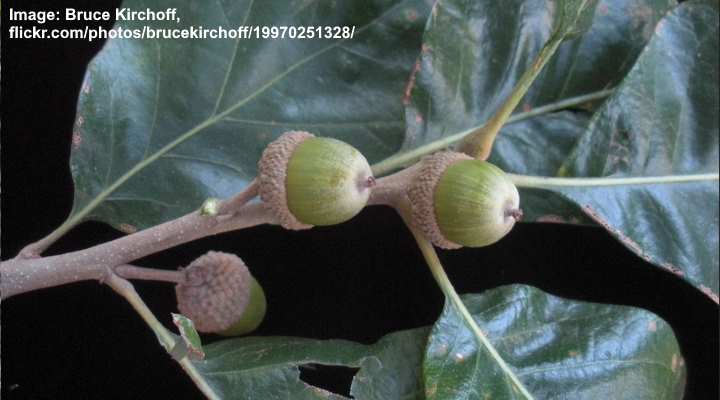
Post oak immature acorns
Post oak tree acorns emerge lime green with grayish-brown warty caps. As the tree nuts mature, they become a darker rusty-red color. The egg-shaped acorns measure 0.5” to 0.75” (12 – 19 mm) and ripen on the tree from September through November.
Blue Oak Tree (Quercus douglasii)
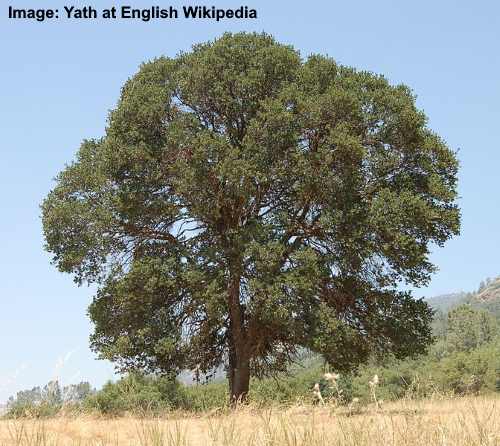
Blue oak tree (Quercus douglasii)
The blue oak is a deciduous tree that produces distinct egg shaped acorns that taper to a narrow point. Native to the western United States, this acorn tree is identified by its bluish-green leaves, 4” (100 mm) long, that turn shades of orange, pink, and yellow in the fall. This medium-sized tree grows 30 to 50 ft. (9 – 15 m) tall and up to 70 ft. (21 m) wide.
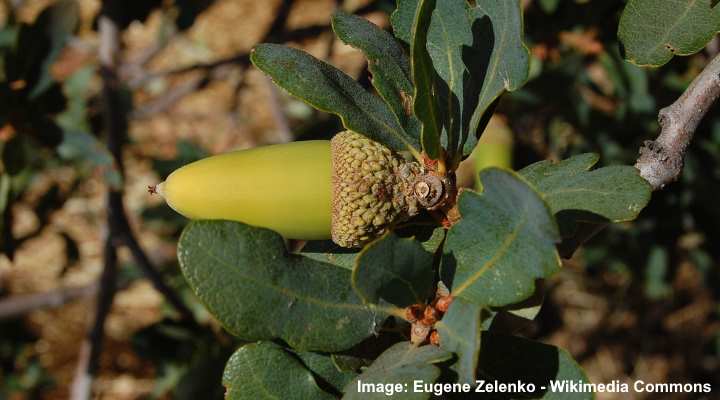
Blue oak immature acorn
Blue oak tree acorns are oblong to oval-shaped and grow 1” (25 mm) long. The acorns help identify these trees because they taper to a point. After emerging green, the elongated acorns become dark brown, almost black.
Overcup Oak Tree (Quercus lyrata)
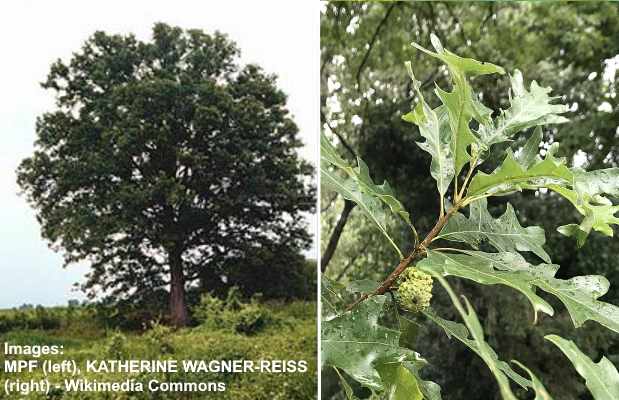
Overcup oak (Quercus lyrata) tree and leaves
The overcup oak gets its name from the tree’s distinctive acorn with a bur-like cap that almost encloses the nut. This oak species is a medium-sized deciduous tree with a broadly rounded canopy. Features of the oak tree are small coppery-brown acorns and long, shiny dark-green wedge-shaped leaves with deeply rounded lobes.
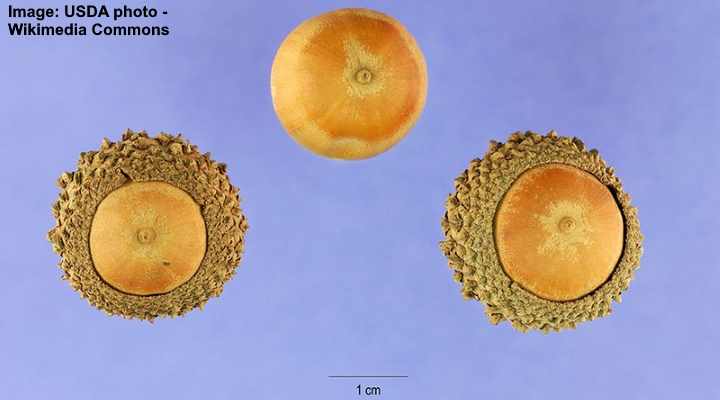
Overcup oak acorns
The overcup oak tree grows 35 to 60 ft. (10 – 18 m) tall and wide. The unusual acorns have a distinct scaly appearance with a smooth top. These oak acorns have a flattened oval to egg shape. They grow 0.5” to 1” (12 – 25 mm) long, and mature overcup oak trees produce acorns after 20 to 30 years.
Swamp Chestnut Oak Tree (Quercus michauxii)
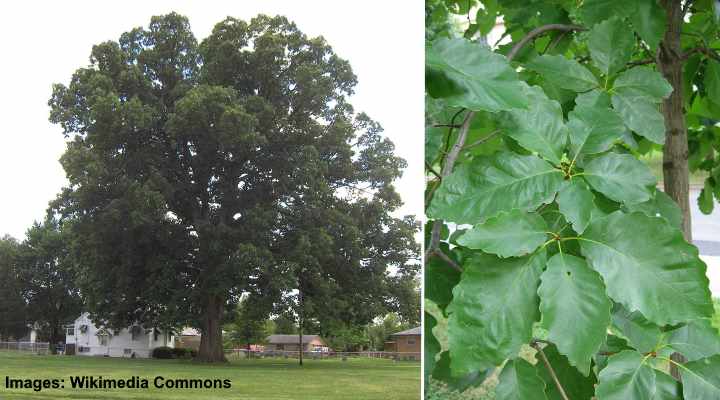
Swamp chestnut oak (Quercus michauxii) tree and leaves
The swamp chestnut oak is one of the many types of oak trees producing acorns. Unlike other oak tree varieties, this species thrives in marshy environments. Identifying features of the oak tree are its lanceolate leaves with serrated margins, barrel-shaped acorns with wide caps, and an oval to pyramidal growth habit.
The swamp chestnut oak grows 60 to 80 ft. (18 – 24 m) tall and 30 to 70 ft. (9 – 21 m) wide.
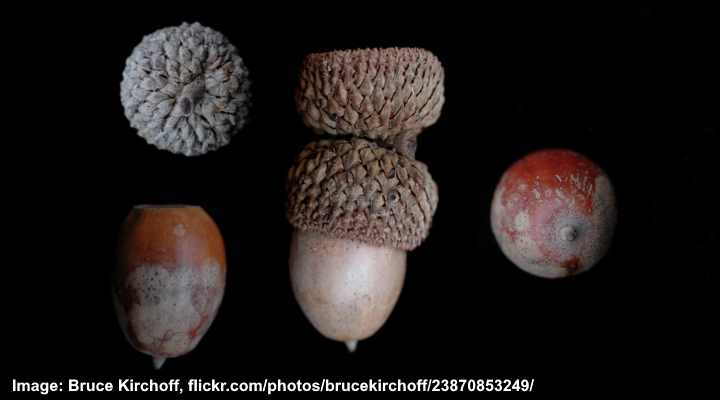
Swamp chestnut oak acorns
Acorns produced by the swamp chestnut tree are relatively large, measuring 1” to 1.5” (25 – 38 mm) long. The large brown oak nuts have caps covering about one-half of the length. Unlike other oak tree acorns, the raw acorns from this species are sweet tasting off the tree.
Dwarf Chestnut Oak Tree (Quercus prinoides)
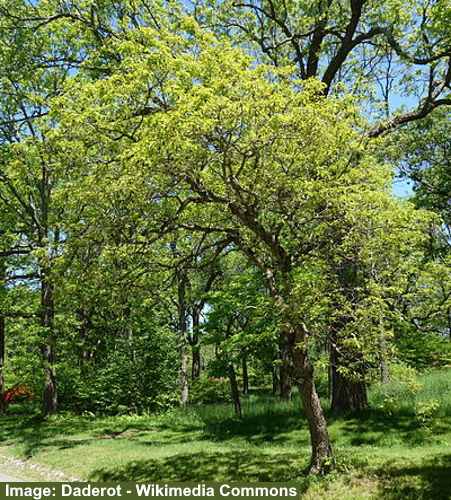
Dwarf chestnut oak tree (Quercus prinoides)
Also called the dwarf chinquapin oak, this small acorn tree is suitable for landscaping small, compact gardens. The sun-loving oak thrives in full sun in temperate climates. This oak species produces light to dark brown acorns and large leathery green leaves with lobed margins. The dwarf chestnut oaks grow 12 to 25 ft. (3.6 – 7.6 m) tall and wide.
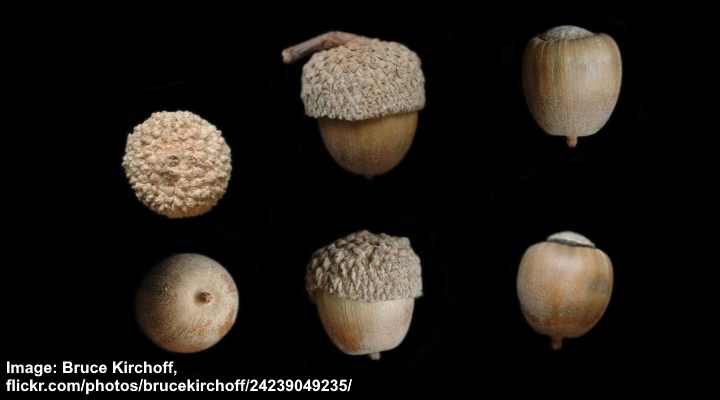
Dwarf Chestnut Oak Tree (Quercus prinoides) acorns
The acorns harvested from the dwarf chestnut oak are light to dark brown and sit in a warty tan-colored cup. The oval, egg-shaped nuts measure 0.5” to 0.75” long, and the cap covers one-third of its length.
Bluejack Oak Tree (Quercus incana)
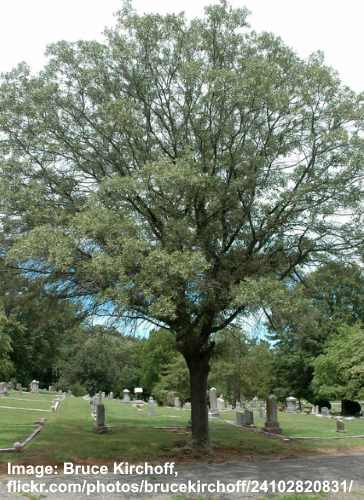
Bluejack oak tree (Quercus incana)
The bluejack oak is a medium sized tree that produces acorns. It has glossy green ovate leaves, a trunk with dark gray platy bark, small stumpy brown acorns, golden yellow flowers and an irregular crown. The attractive glossy leaves create dense foliage, but the dwarf oak tree lacks any fall color. Bluejack oak trees typically grow 30 ft. (10 m) tall.
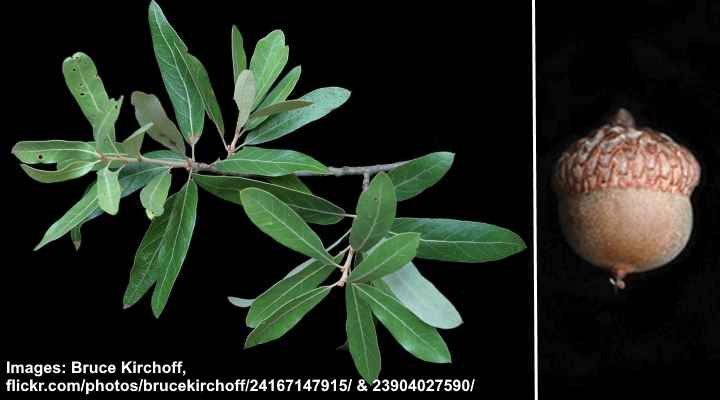
Bluejack oak leaves and acorn
Also called the cinnamon oak, turkey oak, and sandjack oak, this acorn tree has small nuts 0.5” (12 mm) long. The brownish acorns have a smooth surface, and the acorn sits in a reddish-brown scaly cap.
Related articles:
- Florida Oak Trees – Identification Guide
- White Oak Tree – Identification and Growing Guide
- Red Oak Tree – Identification and Care Guide
